





 |
 |
 |
   |
Turner Family in Devon and London, England & Immigration to the U.S.
|
|||||||||||||||||||||||||||||||||||||||||||||||||||||
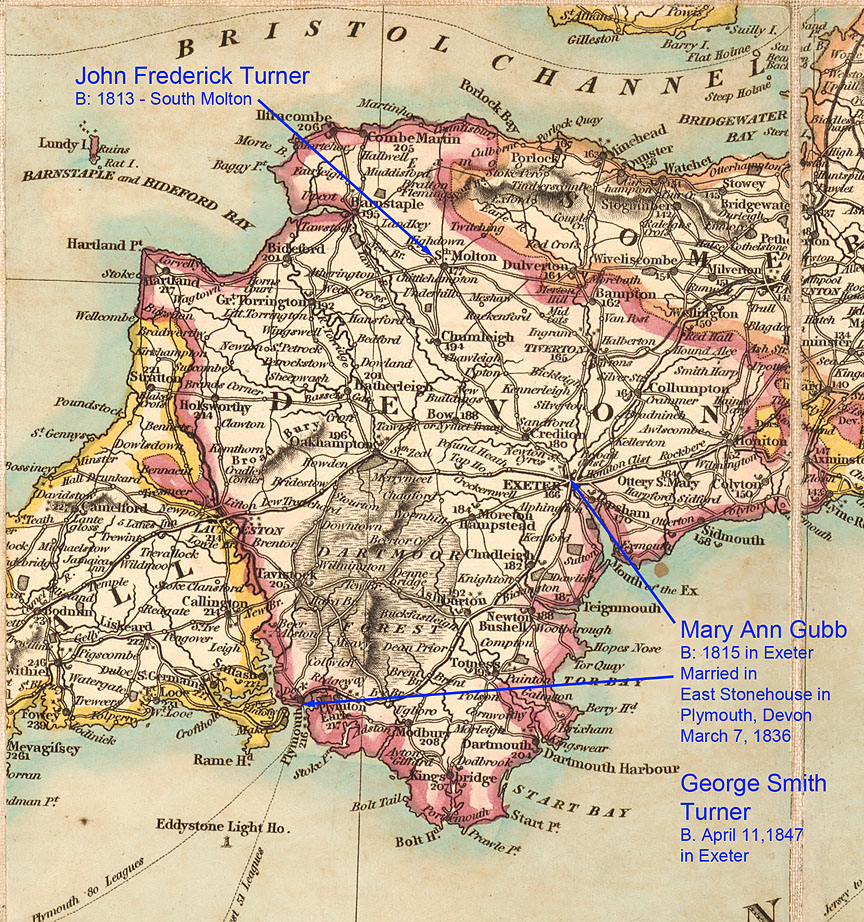 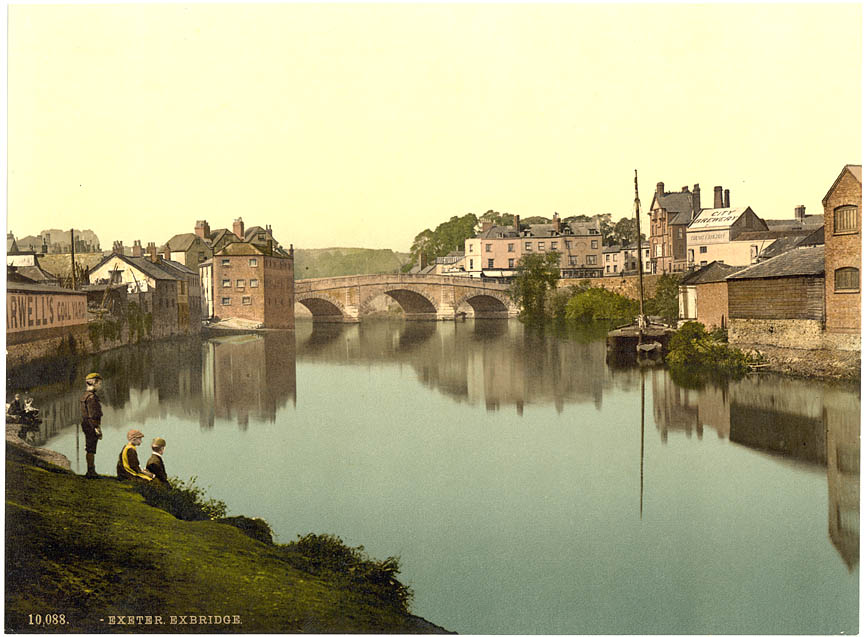 1823 Map of Devon, England and a 1900 view of of the Exbridge over the Ex River in Exeter, Devon, England. Map and photochrom print from the Library of Congress. |
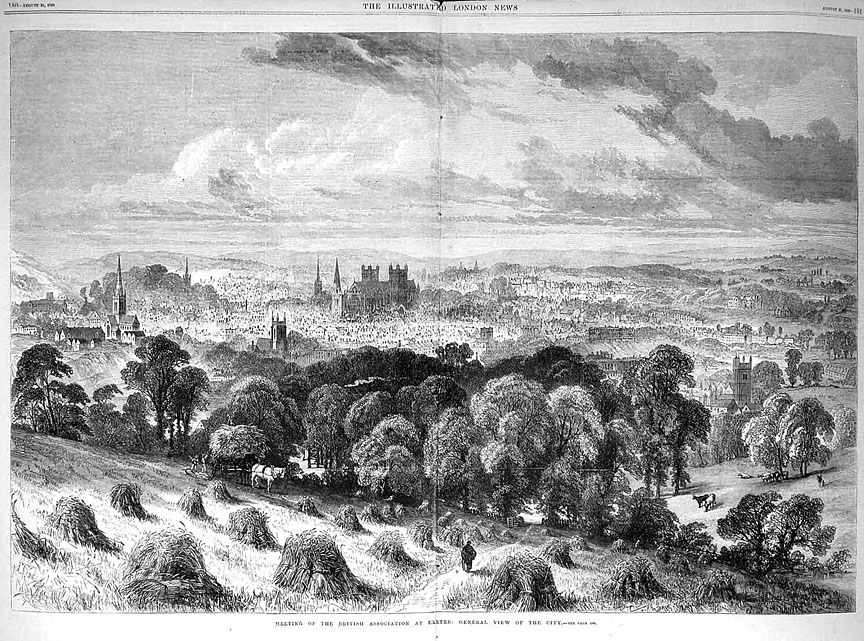 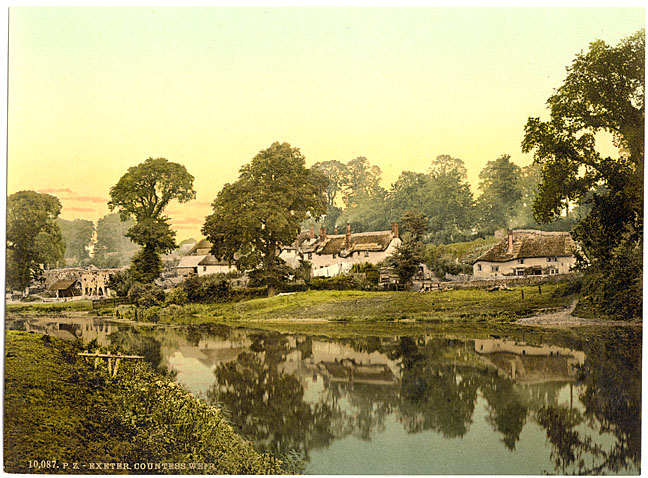 Like most of England, towns such as Exeter were along rivers, surrounded by farms and small agricultural communities with thatch covered homes and fields filled with rye, wheat, barley, peas, oats and lentils. The 1869 black and white print is from the Illustrated London News (from eBay listing) and 1900 photochrom print from the Library of Congress |
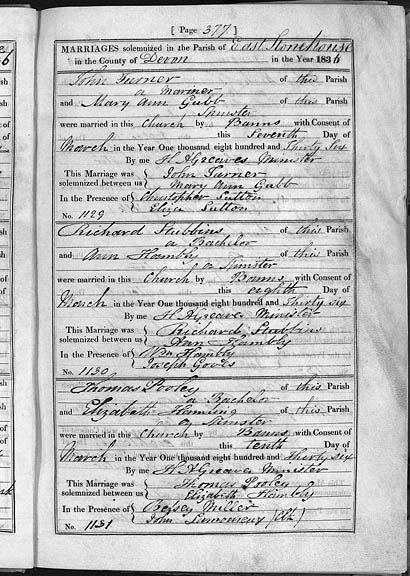 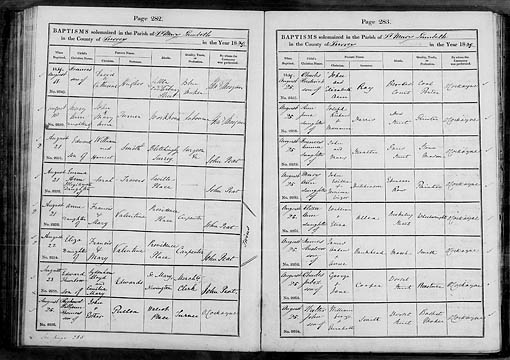 John Frederick Turner worked as a mariner in 1836, an engine fitter in 1851, a farmer in 1861 and railroad a foreman in 1871. John was born in 1813 in South Molton, Devonshire, England. He lived in the Devon area much of his life according to census data and was married to Mary Ann Gubb, a spinster at the church in East Stonehouse, Devon on 7 March 1836. They had at least nine children including George Smith Turner in 1847 and Mary Ann, baptised in 1839 in Lambath, London. |
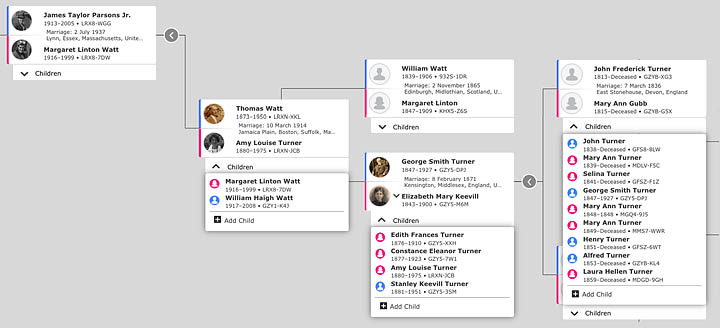 |
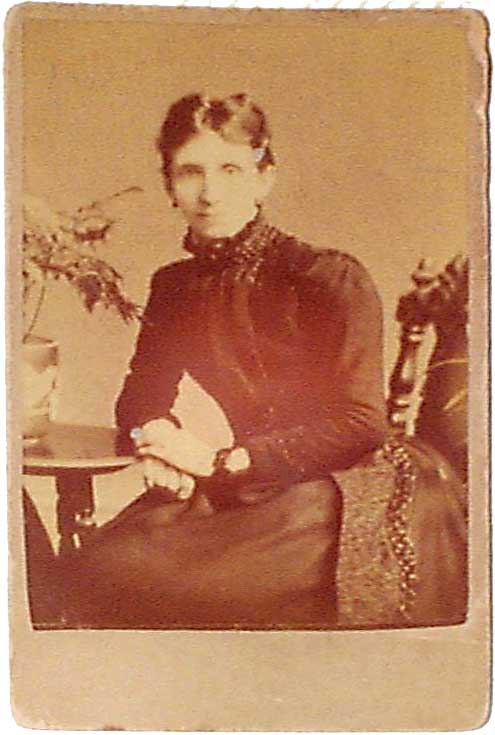 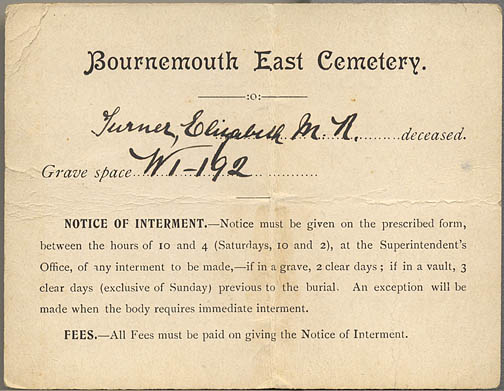 George's 1st wife, Elizabeth Mary Roberts Keevil Turner was born 11 November, 1843, died 1 February, 1900 and was interred at Bournemouth East Cemetery near London. |
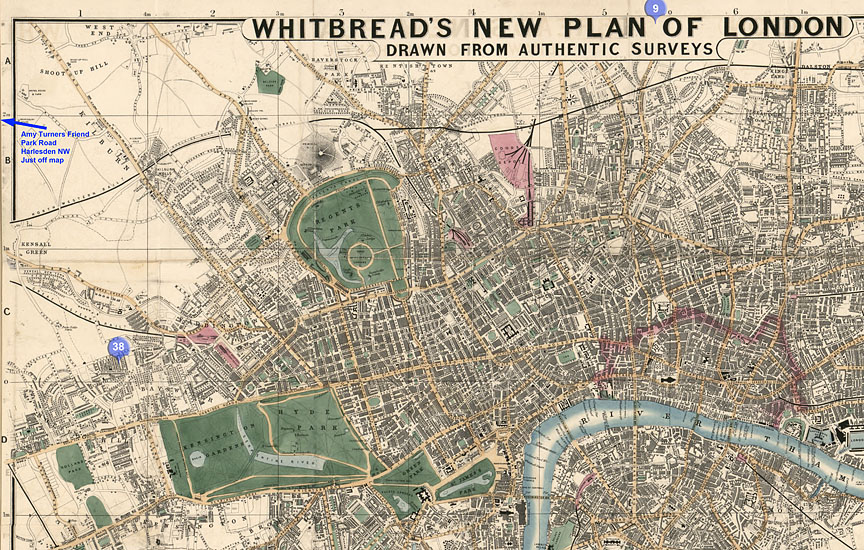 The calling card addresses of 38 Northumberland Place is just north of Kensington Gardens and Hyde Park. 9 Roseleigh Avenue was just off the map, north of downtown London. The Harlesden NW district of Amy's friend (post card below) is just off the map on the west side. 1853 Map from Library of Congress. |
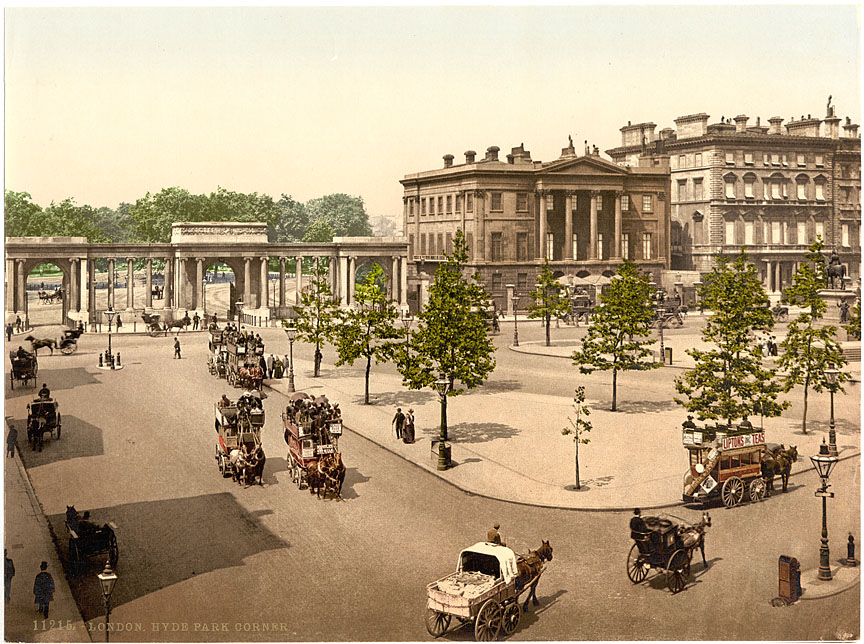 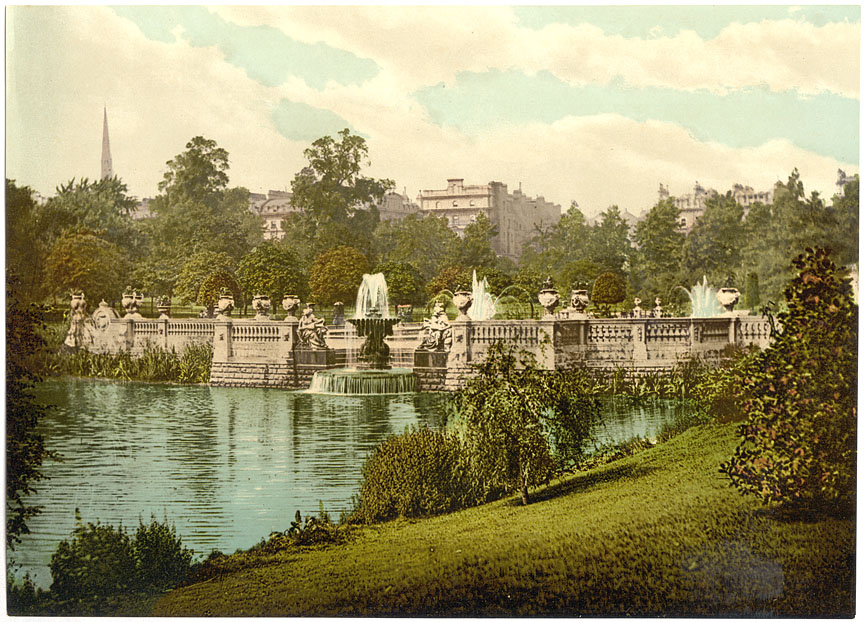 Elizabeth Mary Roberts Keevil must have trotted by in a carriage or walked through the nearby Hyde Park and Kensington Gardens before she was married. 1900 photochroms from Library of Congress. |
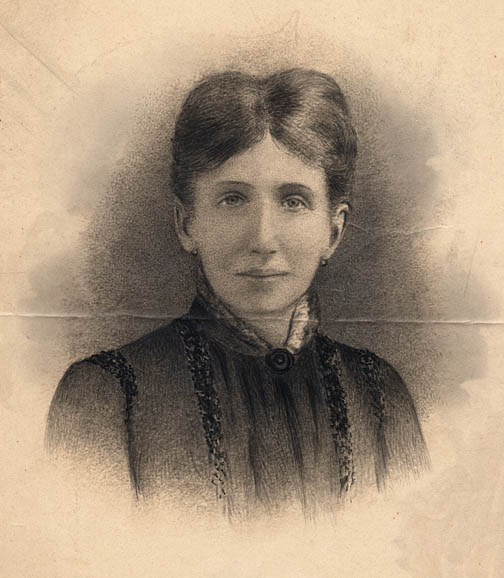 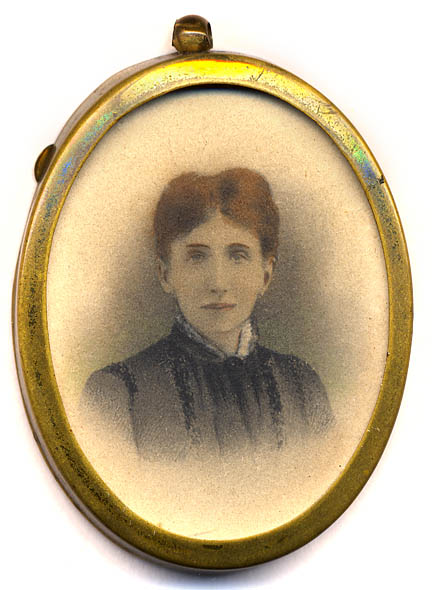 Portrait of Elizabeth Mary Roberts Keevil Turner by her daughter Amy Louise Turner or even Stanley, another family artist. Elizabeth is wearing an almost identical dress pictured in the cabinet card photograph above. Held in a small locket sized frame, a tiny hand tinted photograph of the Elizabeth Turner artwork shows a bit of reddish hair not in the original artwork. Most likely the work of her daughter, Amy Louise Turner. Elizabeth was born 11 November, 1843 and died 1 February, 1900 in London. |
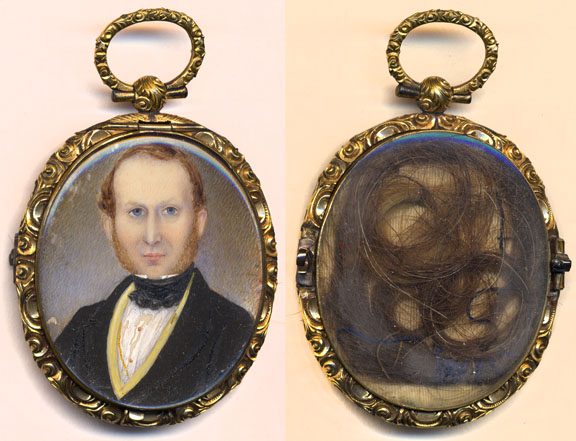 Most likely an early, home made portrait of George Smith Turner to match the small portrait of Elizabeth, perhaps even painted by his daughter Amy Turner, or even her brother Stanley Turner, another family artist. If the blue eyed portrait represents, George, his characteristic bald head and bearded chin followed him into his greying years. A lock of reddish brown hair tied with string also remains behind the glass on the opposite side of the small portrait. Similar small portraits with hair on the opposite side are known as an English mourning brooch. |
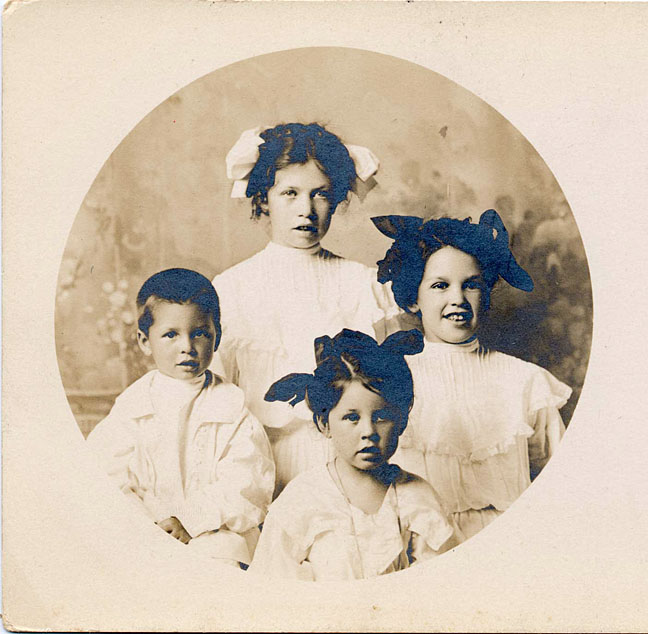 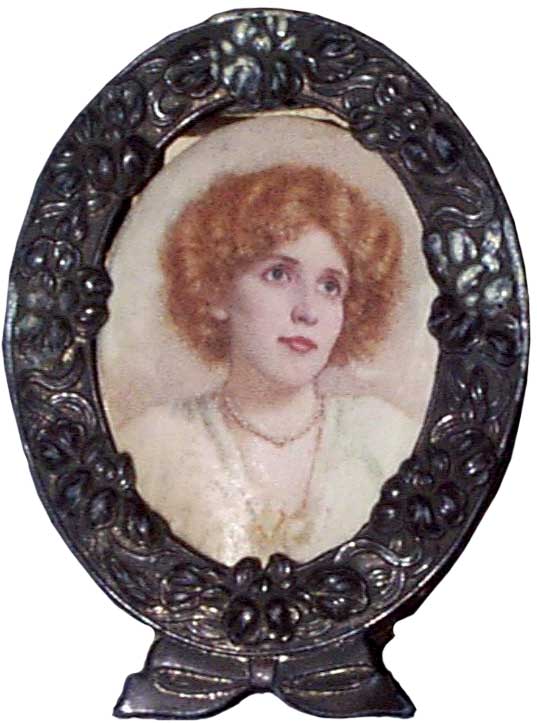 Late 1880s Turner children in a postcard photo - Pictured clockwise L to R - Stanley (b. 1881), Edith Francis (b. approx. 1876) Constance (b. 1878), Amy Louise (b. 1880) Daughter. The oval frame pictures Amy Louise Turner with red hair. She was born January 14, 1880 and lived 95 years, outliving all her siblings and died 18 July, 1975. She immigrated to the U.S. in 1908 from London via Quebec and stayed with her father in Minnesota into 1909 where she helped in missionary work and most likely at his church where, a Miss Amy Turner received a postcard from a London friend at The Manse, Tower, St. Louis County, Minnesota. Around 1910 she went to The Gordon School of the Newton Theological Institution in Boston and graduated on May 14, 1911. In 1912 she was living at 139 W. Concord Street and later, 7 Concord Square, both in Boston. By 1913, she was receiving letters from Thomas Watt and married to him in 1914 and living with their family in Lynn, Massachusetts. |
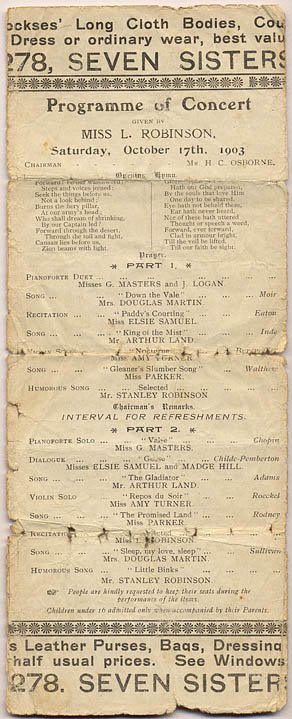 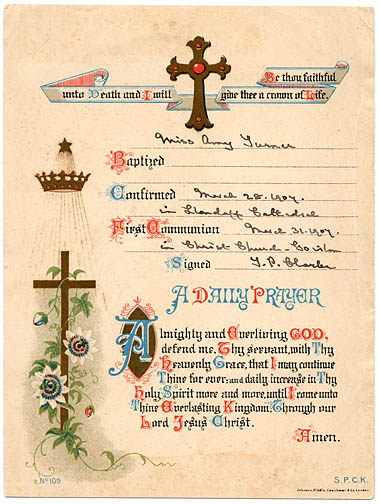 On October 17, 1903 Amy Turner plays a violin solo during a concert in London for King Edward VII performing "Repos du Soir" (Evening rest) by Roeckel (perhaps Joseph Roeckel - composer 1838-1923). Amy Turner's 1907 confirmation and first communion was at the Anglican Llandaff Cathedral in Cardiff, Wales built in 1107 and one of the oldest Christian sites in Britain, founded in the sixth century. The 1907 confirmation also corresponds with the census data and her arrival in the U.S. in 1908. |
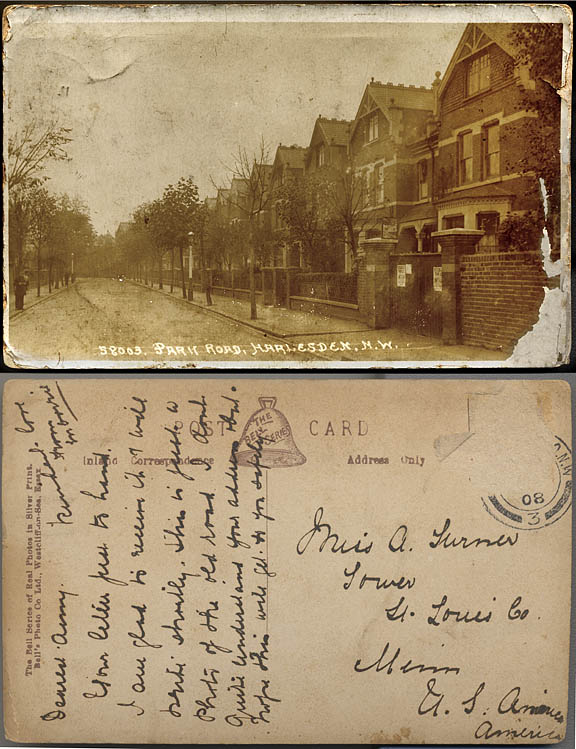 Miss Amy Turner, while in Tower, Minnesota receives a postcard in 1908 from a friend. The photo shows a typical London suburb street with tightly packed homes near where the Turner family once lived. "Dearest Amy, your letter just to hand. I am glad to receive it. I will write shortly. This is just a photo of the old road. I don't quite understand your address but hope this will get to you safely. Kindred love from Carrie." |
|
|
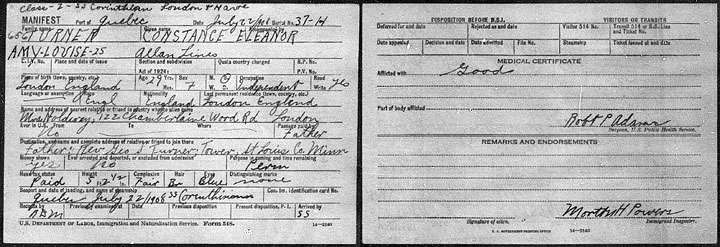 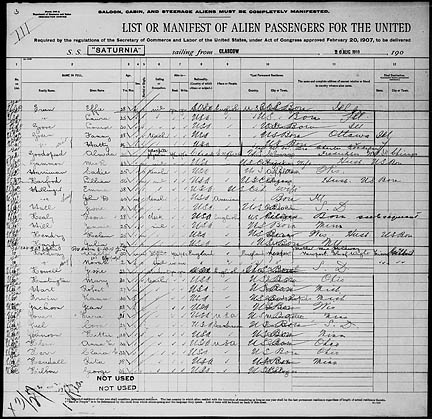 Constance Eleanor Turner, single, 29 years old, with brown hair and blue eyes standing 5' 2-1/2" arrived in Quebec on July 22, 1908 accompanied by her sister, Amy Louise Turner, 25 years old (actually 27) aboard the S.S. Corinthian in a 2nd class cabin paid for by her father, a Rev Geo S. Turner residing in Tower, St. Louis County, Minnesota. A couple of years later on August 20, 1910, Walter Holdway and his daughter Norah arrive in Canada from Glasgow, Scotland on the S.S. Saturnia and cross into Vermont via the St. Albans Canadian Border Crossings bound for Gilbert, Minnesota. Norah's mother Edith had died a few month's earlier on January 26, 1910 in London after giving birth to her second daughter, Irene who also died after living only 16 days.
 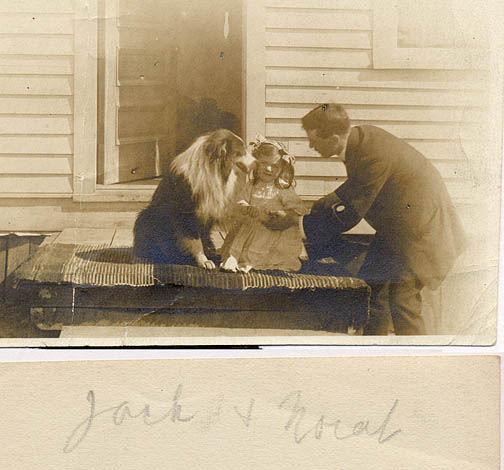 Constance Eleanor or 'Nellie,' now married to her deceased sister's husband sits on the front porch steps with their dog 'Mist' having made her way to Minneapolis, Minnesota. Photographers switch positions as Nellie clicks a photo as her new husband 'Jack' as he poses his daughter Norah with the dog this time sitting on a rug. |
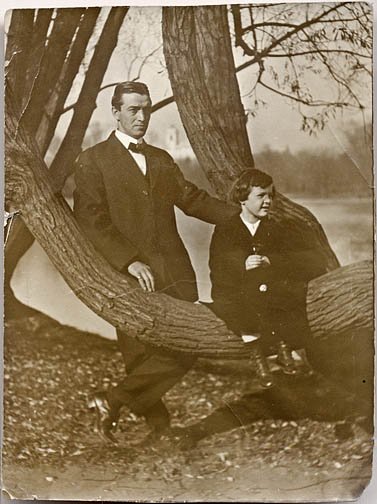 A few years later, Walter John Holdway 'Jack' stands with his daughter Norah at Loring Park Minneapolis, Minnesota about 1912. 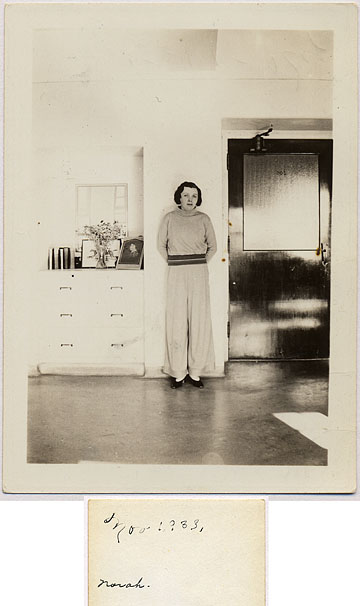 Norah in November, 1933 most likely living at the Howell Sanitarium in Michigan with room number 205 printed on the door. |
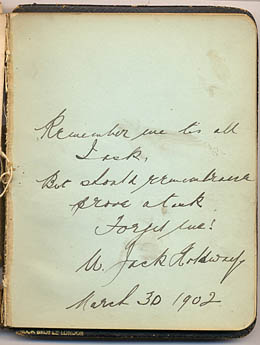 Jack quotes the Irish poet William Percy French's Poem in Amy Turner's Album - "Remember me tis all I ask But should remembrance prove a task forget me!" W. Jack Holdway March 30, 1902 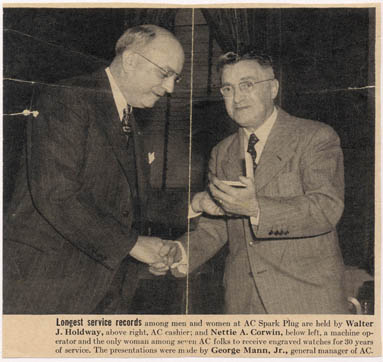 Walter Holdway receives engraved watch for 30 years of service at AC Spark Plug. Jack married a third wife, Nellie Colgate in 1925. Jack lived 67 years and died in 1949 soon after retiring from AC while planning an extended vacation. |
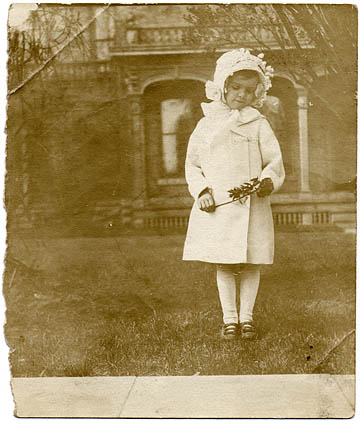 Edith's daughter, Norah Holdway holds a branch with maple leaves. Both of their lives were cut short with Norah spending much of her life in 'sanitariums' to treat TB. Jack's and Edith's second daughter Irene, born in 1910 after Norah, only lived 16 days. Edith died soon after, also in 1910, of lobar (lung) pneumonia only living 34 years. It was possible Jack was a carrier for TB and didn't even know it. Norah only lived 32 years, died at Howell Sanitarium in Michigan on 11 August 1940 after fighting more than 12 years 'duration' of TB and its debilitating side effects. Edith's sister and Jack's second wife, Constance or Nellie lived only 40 years dying of mitral stenosis known as afib or irregular heart rhythm dying in 1923. Edith and Constance's brother Stanley wrote in 1916 (letter below) that "I’m afraid Nellie is, as you say, ill" and Nellie's health "looks very bad" and "I hope Nellie is all right. I’m rather afraid of Consumption with her." |
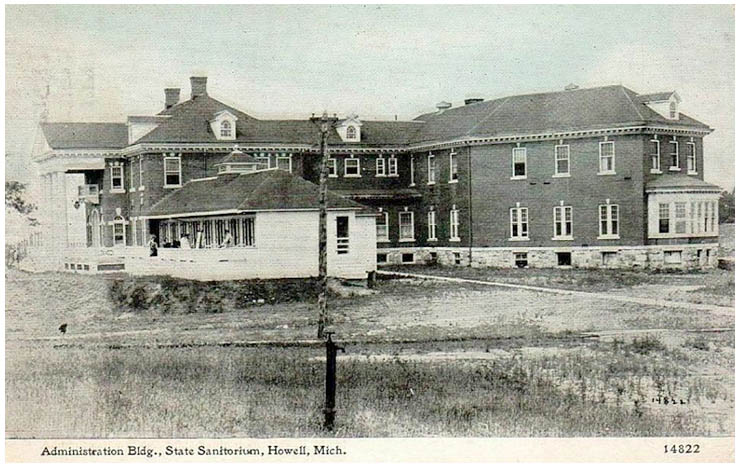 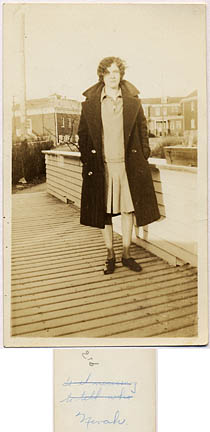 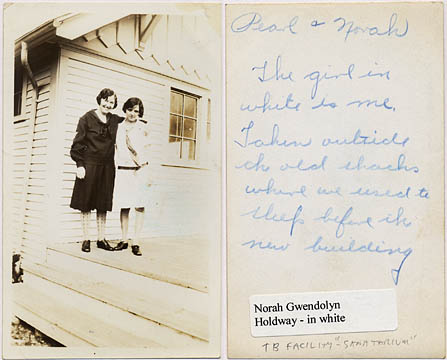
Norah spent much of her adult life at the The Howell Sanatorium where she is pictured in front of the administration building in the 1930s and in front of one of the 'shacks' in the 1920s. Also known as the Michigan State Tuberculosis Sanatorium, it was established in 1905 by a special act of legislature for those suffering from tuberculosis and opened in 1907 with a capacity of sixteen and soon was increased to 50. Situated two a half miles southeast of the town of Howell the facilities sit on a hill at 1,100 feet with 270 acres, 192 of which were donated by town residents. An administration building contained offices, dining room, kitchen, laboratory, laundry and staff. Three infirmary 'shacks' housed patients during the day and night where they received care. A small lake at the entrance allowed patients to fish and boat and the surrounding prairie provided a natural refuge. In later years the facility was transitioned to 500 beds with men’s and women’s shacks and kids cottages. As TB numbers dropped it changed names and was converted to a mental health facility. Eventually, the buildings on High Hillcrest Drive were torn down in 1980. Unfortunately, Edith, Norah and Constance missed the treatment and medication advances in the 1940s, antibiotic advances in the 1950s and reduction of treatment duration from months to weeks in the 1970s and 80s. Today, drug resistant forms of TB are gaining footholds in Asia as treatment times are still an ongoing issue. |
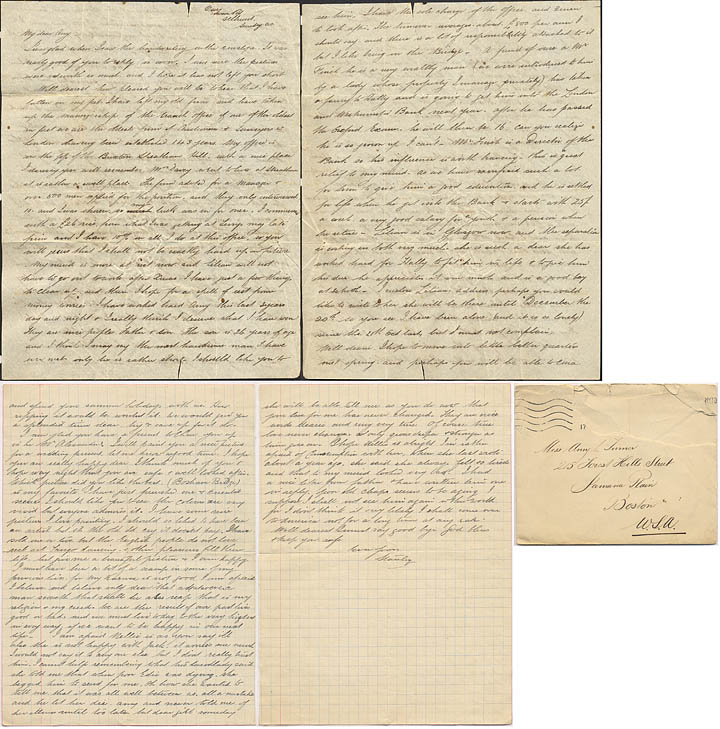 Stanley describes his disappointment of not receiving earlier notice of Edith's poor health and her desire to see him and resolve their issues before her untimely death. His letter also describes his worry for his other living sister in 1916 and notes "I’m afraid Nellie is, as you say, ill" and Nellie's health "looks very bad" and "I hope Nellie is all right. I’m rather afraid of Consumption with her." |
Saxon Rd. Selhurst Sunday eve (about 1916) My dear Amy, I was glad when I saw the handwriting on the envelope. It was really good of you to reply so soon. I am sure the pictures were not worth much and I hope it has not left you short. Well dearest, how pleased you will be to hear that I have fallen on my feet. I have left my old firm and have taken up the managership of the branch office of one of the oldest, in fact we are the oldest, firm of Auctioneers & Surveyors in London, having been established 143 years. My office is on the top of the Buxton Streatham Hill. Such a nice place. I dare say you will remember Mrs. Davey went to live at Streatham. It is rather a swell place. The firm asked for a manager & over 500 men applied for the position and they only interviewed 10 and I was chosen, so my luck was in for once. I commence with a £26 rise from what I was getting at Terrys, my late firm, and I have 10% in all I do at this office, so you will guess that I shall not be exactly hard up in the future. My mind is more at rest now and Lilian will not have to go out to work after Xmas. I have just a few things to clean up and then I hope for a spell of rest from money worries. I have worked hard, Amy, these last 3 years day and night & I really think I deserve what I have won. They are nice people, Father & Son. The son is 26 years of age and I think I may say, the most handsome man I have ever met only he is rather short. I should like you to see him. I have the sole charge of the office and 3 men to look after. The turnover averages about £800 per ann. I should say and there is a lot of responsibility attached to it but I like being on the Bridge. A friend of ours, a Mr. Finch, he is a very wealthy man (we were introduced to him by a lady whose property I manage privately) has taken a fancy to Hally and is going to get him into the London and Westminster Bank next year after he has passed the Oxford Exam. He will then be 16. Can you realize he is so grown up. I can’t. Mr. Finch is a Director of the Bank so his influence is worth having. This is a great relief to my mind as we have sacrificed such a lot for him to give him a good education and he is settled for life when he gets into the Bank and starts with 25₤. a week. A very good salary for a youth & a pension when he retires. Lilian is in Glasgow now and the separation is costing us both very much. She is such a dear. She has worked hard for Hally to fit him in life and to give him his due, he appreciates it very much and is a good boy at school. I enclose Lilian’s address. Perhaps you would like to write to her. She will be there until December the 20th. So you see, I have been alone (and it is so lonely) since the 20th October last. But I must not complain. Well dearie, I hope to move into little better quarters next spring and perhaps you will be able to come and spend your summer holidays with us. How ( ) it would be, wouldn’t it? We would ( ) you a splendid time dear. Try & save up for it - do. I am glad you have a friend to cheer you up. Is he Mr. Alexander? I will paint you a nice picture for a wedding present. Let me know in good time. I hope you are really happy, dear. I think much of you & hope every night that you are safe & well looked after. Which picture did you like the best? Bosham Bridge is my favorite. I have just finished one & Oriental scene. I should like you to see the colors are very vivid but everyone admires it. I have some nice pictures. I love painting. I should so liked to have been an artist but it’s the old old cry - it doesn’t pay. I have sold one or two but the English people do not love real art. Tango dancing & other pleasures fill their life. But give me a beautiful picture & I am happy. I must have been a bit of a scamp in some of my previous lives for my Karma is not good. I am afraid I believe and believe only dear "that whatsoever a man soweth, that shall he also reap." That is my religion & my creed. We are the result of our past lives, good or bad and we must live today to the very highest in every way if we want to be happy in our next life. I’m afraid Nellie is, as you say, ill. Also, she is not happy with Jack. It worries me much. I would not say it to anyone else, but I don’t really trust him. I can not help remembering what his landlady said. She told me that, when poor Edie was dying, she begged him to send for me. Oh, how she wanted to tell me that it was all well between us. All a mistake and he let her die, Amy, and never told me of her illness until too late but dear girl someday she will be able to tell me as you do now that your love for me has never changed. They are nice words dearie and ring very true. Of course, true love never changes - only grows deeper and stronger as time goes on. I hope Nellie is all right. I’m rather afraid of Consumption with her. When she last wrote, about a year ago, she said she always felt so tired and that, to my mind, looks very bad. I had a nice letter from Father & have written him one in reply. Poor old chap - seems to be aging. I suppose I shall not see him again in this world for I don’t think it very likely I shall come over to America - not for a long time at any rate. Well dearest, I must say good bye. God bless & keep you safe. Ever yours, Stanley |
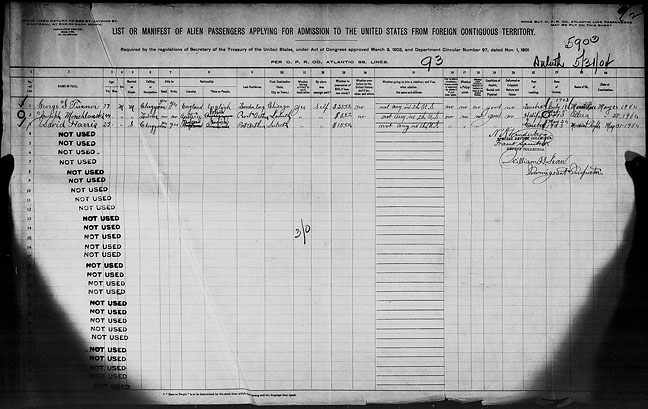 Forging a path for his family to follow to the U.S., George dives into a trans-Atlantic adventure at 57 years old. Listed as a "Clergyman" and able to read and write, George Turner arrived at Quebec, Canada on July 18, 1903 aboard the "SS Mount Rose" or most likely the SS Montrose, a Canadian Pacific ship from England. He is also listed as married on the entry, however his first wife had died in 1900 in London. His future, second wife was 26 years younger than himself. Mary Elizabeth Shannon, born May 7, 1873, was still living in Duluth in 1905 with her parents and four siblings at the age of 32. Nevertheless, George and Mary Shannon would be married during a Duluth spring wedding in 1907.
A week later, he hops a train, the Canadian Pacific Railroad and arrives on May 31 1904, again through U.S. Immigration, this time at Duluth, St. Louis County, Minnesota, on the tip of Lake Superior. He rides another train, the Duluth Missabe & Northern Railway northbound from Lake Superior and travels through the marshy, pond filled and heavily forested Minnesota scenery. He arrives at a small town cut out of the forest, Eveleth, and begins his ministering to the iron miners and loggers of the area from 1905 to 1906. In town, he also joins the Masons, the Eveleth Lodge #239 which is chartered through the Grand Lodge of Minnesota, AF&AM, which in turn, is recognized by the United Grand Lodge of England. |
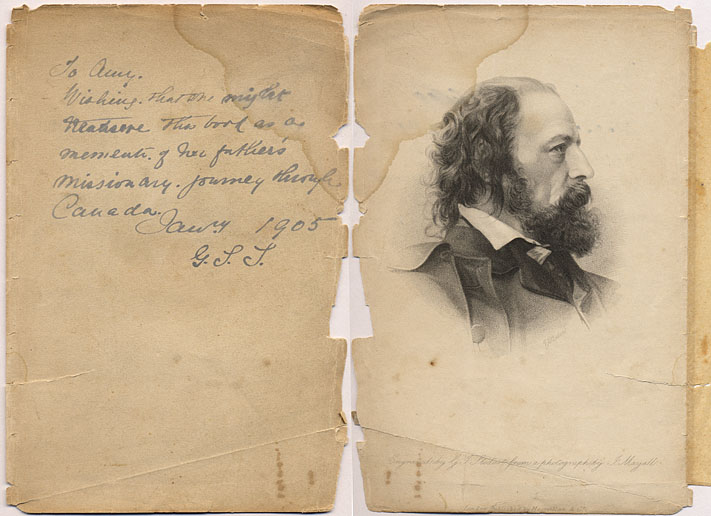 While in Eveleth, Minnesota in 1905, George inscribes the 1898 book The Works of Lord Alfred Tennyson published in London, with "To Amy, Wishing that one might treasure this book as a momento of her father's missionary journey through Canada. January 1905 G.S.T."
According to the 1906 Duluth Evening Herald published on October 14, 1906, "Rev. George S. Turner of Duluth, the new pastor of the St. James Presbyterian church arrived in the city last Saturday and will conduct services at the Presbyterian church every Sunday morning and evening." Just six months later, George would find Mary and they would be married. The Tower Weekly News reported on April 19, 1907:
Rev. Geo. S. Turner, pastor of St. James Presbyterian church in this city, and Miss Mary E. Shannon of Duluth, were quietly married at the home of Mr. and Mrs. I. S. Moore, in Duluth, last Saturday noon. Rev. S. A. Jameson read the marriage service. Rev. Turner and bride arrived here Saturday evening and began housekeeping in the Presbyterian parsonage. They were tendered a reception Thursday evening by the members of the church and were presented with a number of handsome gifts. Rev. Turner has been in charge of the Presbyterian church since last October and is exceedingly popular among members of his congregation as well as others who enjoy his acquaintance. Mrs. Turner has been engaged in church and bethel work in Duluth and other cities for several years." Mary was a well established woman working hard for charitable organizations in Duluth. For a number of years starting early as 1902, she was Bethel Home Superintendent, a family shelter and "rescue home for unfortunate women" in Duluth. The Bethel Home was originally started in 1873 as a family rescue for the frontier town of Duluth which "was was one of those larger "logging camp towns" which with the "cow towns" of the west are fast disappearing into the pages of history - picturesque in perspective, painted with the glamour of the frontier, but crudely bizarre and undesirably "tough" in reality." With community support, the family and women's shelter was a success and yet needed continued support with Superintendent Miss Mary E. Shannon at the helm. After George and Mary's wedding about a year later, his daughters Amy and Nellie would join the married couple while transitioning back to the towns of Tower and Gilbert. The Tower Weekly News records on July 31, 1908, "Misses Constance E. Turner of Wales, Amy L. Turner, of London, England, arrived here last Saturday evening and will make an extended visit with their father Rev. George Turner."
To transport the mineral wealth, the Duluth, Missabe and Northern Railway was established as one of the earliest iron ore hauling railroads in the area, also having built some of the largest iron ore docks in the world at Duluth. Later, the railroad merged, forming the Duluth, Missabe and Iron Range Railway. Both the DM&N and the D&IR were sold to Rockefeller’s U.S. Steel Corporation in 1901. Gilbert had just incorporated as a village in 1908 and through that same year, a manse or parsonage would be built in the town of Gilbert. Through 1909, a church in Duluth was donated to the town and would be moved and reconstructed in Gilbert, where the Presbyterian church board would soon install George as a permanent pastor. According to the local Duluth Evening Herald reported on December 11, 1909 "Rev. Mr. Turner, accompanied by his wife (2nd wife Mary Shannon) and daughter, Miss Amy Turner, left yesterday for Gilbert, where Mr. Turner has accepted a call. Rev. Mr. Turner has been pastor of the Presbyterian church here (Duluth) for the past three years. He will make occasional visits here to conduct services, as his removal leaves his parish without a resident pastor, his successor not having yet been named."
Taking a break from lessons during September 25 to October 23, 1908, the papers would report on Amy's visit to her sister in Minneapolis. The Tower Weekly News paper also reported on January 1, 1909 "At the Presbyterian church next Sunday the pastor Rev. Turner will preach a New Year sermon. Miss Amy Turner will play the "Ave Maria" by Bach Gounod. Junior Christian Endeavor will meet at the Manse at 4 p. m. and the Senior Endeavor at 7 p. m." After eight months more or less with her father and step mother, Amy left for another brief visit with her sister Nellie, still in Minneapolis. The Tower Weekly News reported on April 23, 1909, "Miss Amy Turner left this morning for Minneapolis, where she will visit a week with her sister." Amy would soon return to Gilbert according to newspaper accounts and stay through December 1909. Throughout his time in the north, George, his wife as well as Amy would occasionally travel the short distance back to Duluth for Presbyterian meetings. While in Gilbert, he would also join the Gilbert Knights of Pythias, like the Masons, a fraternal organization and secret society where friendship, charity and benevolence are practiced. George and Mary would live at the Manse from at least 1908 until 1921. The Presbyterian Church next door would be completed in January of 1910 where soon after in 1911 he would maintain a more permanent position. |
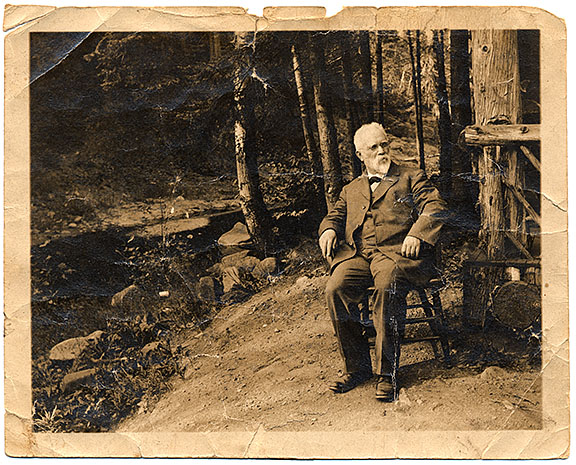 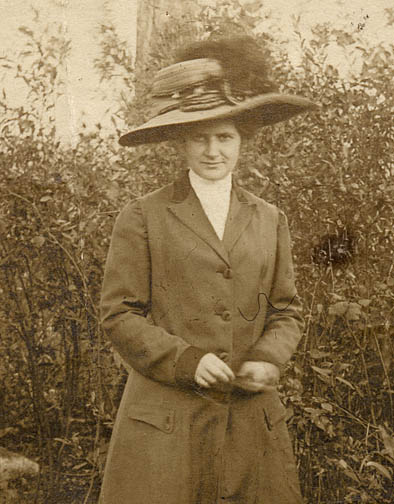 August 25, 1913 - George Smith Turner sits in Lester Park in Deluth, Minnesota, just a short train ride away from Gilbert, in the mining and logging forests up north. Mary Shannon Turner sports a large hat in Gilbert, also in 1913. |
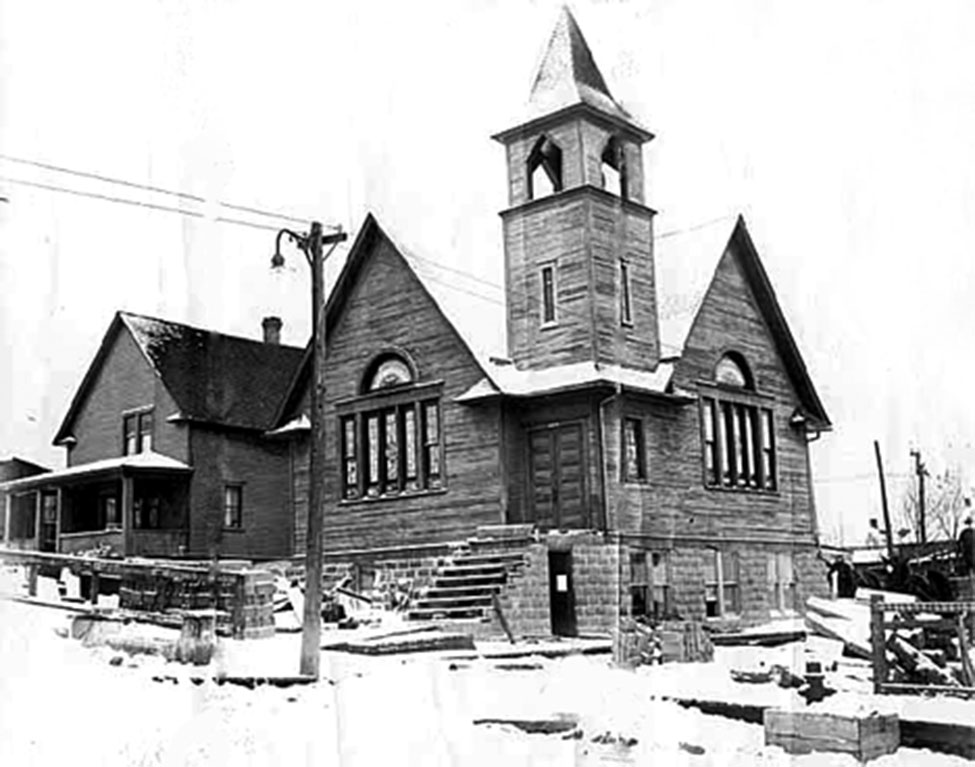 Reconstructed by the Presbyterian Home Mission Board through the fall of 1909, final touches are added to the structure with snow on the roof and ground. A stack of cut stone stands out front as workmen finish the staircase and handrail leading to the front door in the cold winter of 1910. |
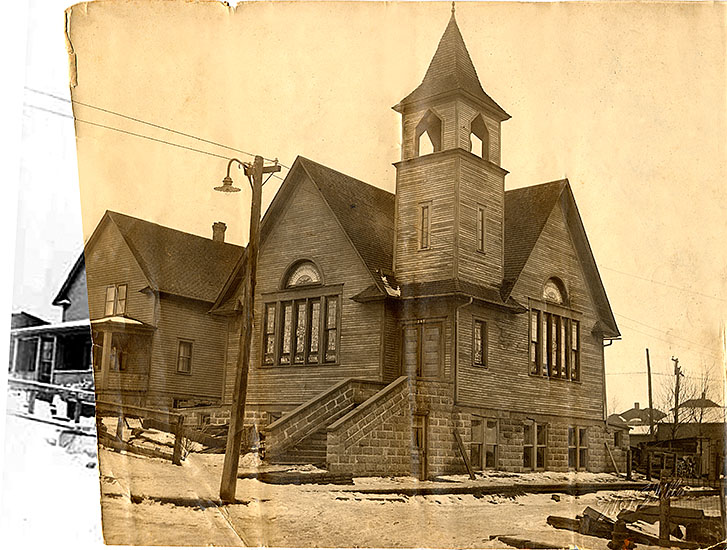 A few days later, with boards leaning against the house, the stone staircase was completed. Most of the snow was melted off the roof and much of the church construction was completed at George's ministry at the First Presbyterian Church in Gilbert, Minnesota where he had been "supplying the pulpit of the Gilbert Presbyterian church for the past two years." |
Duluth Evening Herald. |
|
According to the The Virginia Enterprise of Minnesota, published on January 14, 1910 residents soon dedicated the church: |
Almost a year later, George would take over as the official pastor of the church described in a 1911 news clipping from The Eveleth News: |
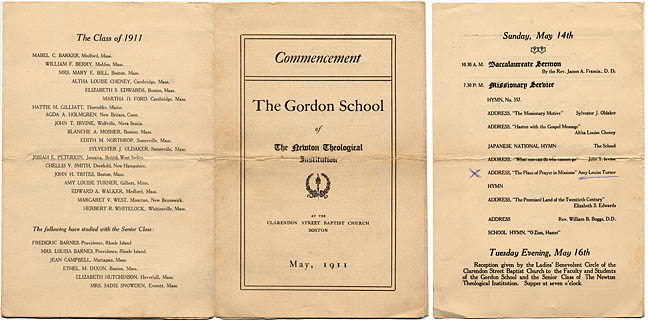 After spending 1908 and 1909 traveling from England and staying in northern Minnesota with her ministering father, Amy returned to Boston and on Thursday, May 18, 1911, Amy Louise Turner from Gilbert, Minnesota graduated from The Gordon School of the Newton Theological Institution in Boston. She gave a missionary service address titled "The Place of Prayer in Missions" given on Sunday, May 14, 1911, no doubt speaking of her recent experiences in the small towns of Minnesota. |
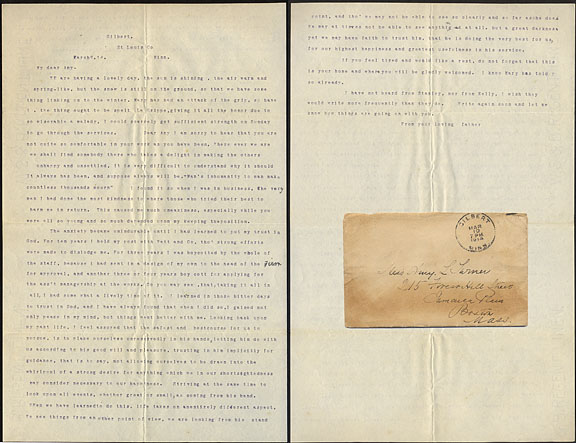 A few years later, George typed a 1914 letter and hand written envelope from his ministry in Gilbert, Minnesota to his daughter Amy, about to be married in Boston to Thomas Watt. |
St. Louis County, Minn. March 8th, 1914 To his daughter: Miss Amy L. Turner 215 Forest Hill Street Jamaica Plain, Boston, Ma. My dear Amy, We are having a lovely day, the sun is shining, the air warm and spring-like, but the snow is still on the ground, so that we have something linking us to the winter. Mary has had an attack of the grip, so have I. The thing ought to be spelt La Grippe, giving it all the honor due to so miserable a malady, I could scarcely get sufficient strength on Sunday to go through the services. Dear Amy, I am sorry to hear that you are not quite so comfortable in your work as you have been. Wherever we are we shall find somebody there who takes a delight in making the others unhappy and unsettled. It is very difficult to understand why it should. It always has been and suppose always will be “Man’s inhumanity to man make countless thousands mourn”. I found it so when I was in business. The very men I had done the most kindness to were those who tried their best to harm me in return. This caused me much uneasiness, especially while you were all so young and so much depended upon my keeping the position. The anxiety became unendurable until I had learned to put my trust in God. For ten years I held my post with Watt and Co, tho strong efforts were made to dislodge me. For three years I was boycotted by the whole of the staff because I had sent in a design of my own to the head of the firm for approval and another three or four years boycott for applying for the ass’t managership at the works. So you may see that, taking it all in all, I had somewhat a lively time of it. I learned in those bitter days to trust in God and I have always found that when I did so, I gained not only peace in my mind, but things went better with me. Looking back upon my past life, I feel assured that the safest and best course for us to pursue, is to place ourselves unreservedly in his hands, letting him do with us according to his good will and pleasure, trusting in him implicitly for guidance, that is to say, not allowing ourselves to be drawn into the whirlpool of a strong desire for anything which we in our shortsightedness may consider necessary to our happiness. Striving at the same time to look upon all events, whether great or small, as coming from his hand. When we have learned to do this, life takes on an entirely different aspect. We see things from another point of view, we are looking from his standpoint and, tho we may not be able to see so clearly and so far as he does, we may at times not be able to see anything at all, but a great darkness yet we may have faith to trust him, that he is doing the very best for us, for our highest happiness and greatest usefulness in his service. If you feel tired and would like a rest, do not forget that this is your home and where you will be gladly welcomed. I know Mary has told you so already. I have not heard from Stanley, nor from Nelly. I wish they would write more frequently than they do. Write again soon and let me know how things are going with you. From your loving father |
|
|
|
|
To: Amy 1501 Marine Drive E. South Vancouver, B.C. Feb. 1923 My dear Amy, Tell Peggy & Billy that we received the Valentines and thought they were very pretty. The weather here is very much like the English climate - very mild - very variable but within limits. Not 100 above and then tomorrow 100 below. Last week it was charming - so fine - sun-shinny and genial. The last two or three days frost and damp. That chills one more than the intense cold. I had a letter from Nelly. She is evidently improving in health. They have removed to a new house which is much warmer and more comfortable than the one they have left. She never mentions Norah - if she does, it is but a casual remark. Norah never writes herself. I have never had a letter once from her. She is kept quite in the background so far as her relatives are concerned. I only hope they are going to give her a good education. Tell Peggy I liked her letters and Mary thinks her drawings are good. If she practices she will be able to make good drawings. I suppose Billy is looking forward to next fall so that he can go to school with his sister. We are beginning to think about moving - our time for this house is drawing to a close. The first week in April we expect the people we have leased it from will be returning to take possession. We shall be leaving the house just as the orchard is in full bloom. The apples, pears, plums, peaches, etc. I have no idea what part of Vancouver we shall settle in. It cannot be prettier than this one. We can see a range of mountains in the distance, straight from our window across the River Frazer and the Straits of Georgia. From the front gate we can see clearly as tho it were only 10 miles away. Mt. Baker in Washington, it’s snowy crest glistening in the sunshine. How do you like your new house? I suppose you are now reveling in the delight of a furnace. Do you have to look after it or does the owner of the home take that part of the work on? How does Tom get along with his work? He will be qualifying for a prominent position as Settler of Disputes over in Ireland. I am glad you are well and happy. With love to all from your loving father G. S. Turner P. S. Just this minute rec’d a letter from you. Tell Billy he is a brave little fellow and I am proud of him. Hope he will grow up a brave good boy: a fine fearless man who fears god - honors his fellow men - hating evil - loving the good. Who was that discredited (B.C.)? Would like to know more about him. Editor’s Note: ( ) words or letters unknown or unrecognizable. This letter was written on a piece of stationery with a letterhead from the First Presbyterian Church with George S. Turner, Pastor, Gilbert, Minnesota printed on it. |
||
1515 Marine Drive E. July 29th , 1927 Dearest Peggy, I was so glad to receive your nice letter that I thought I would answer it at once, but many things came in the way. I hope you are all having a lovely summer going about in your car & to the beaches. Is there a cool porch on your new house? The new address sounds pleasant as if it might be near a park. It has been so hot here for three weeks that we don’t feel like going out in the daytime. But a great many mothers I see take all the children & go to the beach with supper & then after work the fathers join them & they all have a cool evening together beside the water. It’s lovely to see the sun set behind the mountains. The mountains keep changing color as the sun goes down until they are all a dark blue like the sea. I expect you would write a poem about it if you were here. We have had lots of raspberries this year. I have canned 9 quarts & 5 pints and made jelly too. I wish you all could have some. We have white raspberries & black ones in this garden as well as red. I went to Kitsilano beach one day with Mr. Gilbert & Ida who live near us. Ida is fourteen years old. She had a party on her birthday and I went to it. There were eleven girls there. I helped Ida’s mother with the games they played on the lawn. They had a spelling match, a potato race, pinned a tail on a horse & put a chimney on a house and had some other races. Mrs. Gilbert gave prizes to the winners.
Do you like to do fancy work yet, Peggy? I was out at a lady’s house yesterday afternoon & I carried my work in that pretty pink silk bag trimmed with silver bead that you sent me. My niece, Martha Sleepack, who is just your age only her birthday is in March, is a Girl Scout and loves that work. She was at a Scout camp this summer. She & her two sisters swim. Almost everybody here swims. There are so many places where one can learn and so much waters that one might fall into that it certainly is a good thing to know how to keep afloat at least. The fat people can float more easily than we thin ones can. My nieces & nephews here & their mother have been away at a beautiful ranch up the country for a month where there are horses & cattle. Those two boys have been riding horseback nearly all the time but Philip fell off his horse about ten days ago & broke one of his arms. They are coming home tonight. The two girls are eight & fourteen years old. I don’t think they have had quite such a good time as the boys have. I hope you will write again, Peggy dear, but I know you are busy, or will be when school opens again. I love to get your letters. Love to all the family, from Aunt Mary |